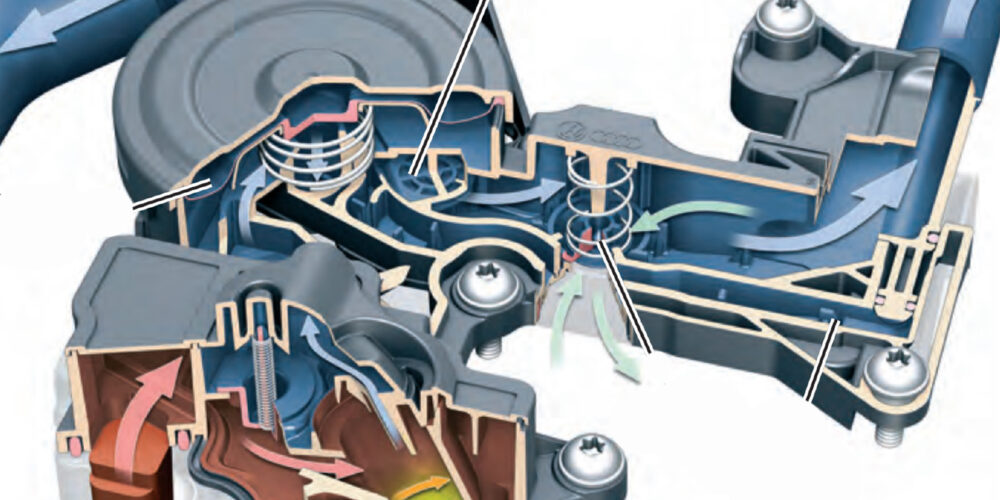By Larry Hammer
Technical Services
Mighty Auto Parts
The purpose of the brake fluid is to transfer force under pressure from the master cylinder to the calipers/wheel cylinders. Non-contaminated fluid is imperative in order to maintain good brakeability, and to retain a high boiling point to prevent gassing and brake pedal fade.
Brake fluid is the most important and yet the most neglected fluid in the vehicle. No attention is given to it until a brake problem or a system overhaul occurs. The fluid extracted may be only a fraction of the system’s total capacity. Some vehicle manufacturers specify a mileage or time interval for a brake fluid flush. Others state “as required,” or “when system contamination occurs.” The industry accepted standard for a system flush is two years or 24K miles. Some new technology that allows field testing of the fluid may just change the way we think, as well as the customer’s decision to have the brake system flushed.
System Contamination
Most consider moisture to be the single contaminating element in the braking system. Considering the hygroscopic nature of the brake fluid, moisture is definitely a problem. Moisture may enter the system through the hoses, seals, master cylinder cover, etc. It is imperative that you keep the brake fluid container tightly sealed when not in use. The system can absorb 2% of its volume in moisture in 12 months. Just leaving the container open on the bench may result in the fluid failing a moisture test. A Dot 3 brake fluid with a 3% moisture accumulation encounters a 25% drop in the boiling point. A Dot 4 fluid has a higher dry boiling point than the Dot 3 fluid, but the wet boiling point may fall more rapidly than the Dot 3 when subjected to moisture. Dot 3 fluids are comprised of mixtures of glycols and glycol ethers.
Dot 4 fluid contains the same mixtures as Dot 3 fluid, but includes borate esters. Both fluids are compatible with the systems and the internal components, but may behave differently when subjected to moisture. A Dot 4 fluid will require more frequent flushes than a Dot 3 fluid. Fluid with a 3% moisture content or higher may not exhibit a braking concern under normal braking. The brake system may perform perfectly when cold, and then encounter pedal fade under aggressive braking. This is due to the fluid in the calipers or wheel cylinders being exposed to high heat, causing the fluid to boil and vaporize. The vapor is a gas and is compressible. The result is a spongy pedal, or in some cases a total loss of pedal. When the system cools, the vapor reverts to a liquid, and normal braking is restored. Moisture in the system may not be evident until periods of aggressive, heavy or extended braking, and that’s not the time to encounter a spongy or dropping pedal.
Moisture creates another major problem in the system, to which little attention has been given, and that is internal corrosion. Until recently, there has been no means of field testing for corrosion. If corrosion inhibitors are present in the fluid, a 5% moisture accumulation will not cause corrosion in the system. However, that level of moisture will deteriorate the corrosion inhibitors in the fluid. Once they are exhausted, a minute amount of moisture will promote corrosion. Studies show that 91% of the corrosion inhibitors may be lost in 36 months. The brake fluid is exposed to a minimum of six different types of metals, rubber components, plastic, and a wide range of temperatures. The fluid must be compatible with these materials and maintain stable performance characteristics over a broad range of temperatures.
Field Testing For Contamination
Field testing of brake fluid has been limited to testing for the presence of moisture. By the time the fluid fails a moisture test, chances are major damage has already been incurred. The moisture depletes the corrosion inhibitors in the fluid, resulting in corrosion damage to the components. Caliper bores, wheel cylinders, the master cylinder and ABS components become pitted, resulting in sticking and binding components and seal leakage. A new technology named FASCAR (Fluid Analysis by Stimulation of Copper Alpha Reactions) has made field testing for fluid contamination simple. The test involves dipping a test strip (Strip Dip) into the brake fluid in the master cylinder reservoir for one second and then waiting for 30-120 seconds for the test results. The reaction zone on the test strip will change color in relation to the condition of the fluid. Compare the color on the test strip to the color graph provided. The presence of copper indicates that system corrosion is occurring. The copper alloy in the brake lines will be the first metal susceptible to the corrosive elements. Fluid that measures 200 PPM (parts per million) of copper or higher should be removed with a system flush.
Mileage has nothing to do with the age of the fluid. Fluid in a 10K mile vehicle may have aged more than a like vehicle with 30K miles. The condition of the fluid is determined by factors such as the customer’s braking habits, pulling or hauling a heavy load, high brake temperatures, mountainous driving, etc., all of which accelerate the breakdown of the corrosive inhibitors. Brake fluid wears out and should be changed, just like antifreeze must be replaced to restore the cooling system’s corrosive inhibitors.
For information on Mighty Auto Parts, visit www.mightyautoparts.com.









